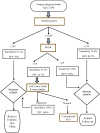Standard Clinical Screening Tests, Sural Radial Amplitude Ratio and F Wave Latency Compared to Conventional Nerve Conduction Studies in the Assessment of Sensorimotor Polyneuropathy in Patients with Type 2 Diabetes Mellitus
- PMID: 35355904
- PMCID: PMC8959202
- DOI: 10.4103/ijem.ijem_426_21
Standard Clinical Screening Tests, Sural Radial Amplitude Ratio and F Wave Latency Compared to Conventional Nerve Conduction Studies in the Assessment of Sensorimotor Polyneuropathy in Patients with Type 2 Diabetes Mellitus
Abstract
Background and aims: The measuring tools used for assessment of neuropathy include various questionnaires, monofilament testing, Biothesiometry and the gold standard test, nerve conduction studies (NCS). This study aims to evaluate the diagnostic accuracies of Michigan Neuropathy Screening Instrument (MNSI), Biothesiometry, Semmes Weinstein Monofilament (SWMF), Sural Radial Amplitude Ratio (SRAR) and minimal F wave latency as compared to conventional NCS and arrive at a simple diagnostic algorithm for early detection of Diabetic Peripheral Neuropathy (DPN).
Methods: In a cross-sectional observational study on 48 Type 2 diabetes mellitus patients, MNSI, Biothesiometry, SWMF and NCS including F waves and SRAR were done and diagnostic accuracies (sensitivity, specificity, positive and negative predictive values) calculated taking NCS as gold standard.
Results: MNSI, Biothesiometry, SWMF, SRAR and minimal F wave latency had a sensitivity of 64.3%, 78.6%, 14.3%, 100% and 78.6% and specificity of 67.7%, 52.9%, 94.1%, 23.53% and 76.47% respectively, with reference to NCS. Based on combined sensitivities and specificities, we arrived at a simple algorithm for early diagnosis of DPN, which showed that DPN could either be diagnosed or ruled out in 75% of the patients by a combination of the Biothesiometry, SRAR and left lower limb minimal F wave latency results.
Conclusions: In the setting of an outpatient, multidisciplinary diabetic clinic, simple tests such as questionnaires, monofilament testing and biosthesiometer could be performed with greater ease while considering NCS as the gold standard. This algorithm, combining Biothesiometry, SRAR and left lower limb minimal F wave latency would be less time consuming and help in early diagnosis of DPN.
Keywords: Biothesiometry; F wave; diabetic peripheral neuropathy; nerve conduction studies; sural radial amplitude ratio.
Copyright: © 2022 Indian Journal of Endocrinology and Metabolism.
Conflict of interest statement
There are no conflicts of interest.
Figures
Similar articles
-
Sural-to-medial femoral cutaneous amplitude ratio in early diagnosis of uremic neuropathy.Muscle Nerve. 2025 Jan;71(1):80-86. doi: 10.1002/mus.28292. Epub 2024 Nov 8. Muscle Nerve. 2025. PMID: 39512177
-
The usefulness of minimal F-wave latency and sural/radial amplitude ratio in diabetic polyneuropathy.Yonsei Med J. 2000 Jun;41(3):393-7. doi: 10.3349/ymj.2000.41.3.393. Yonsei Med J. 2000. PMID: 10957895
-
Effectiveness of Semmes Weinstein 10 gm monofilament in diabetic peripheral neuropathy taking nerve conduction and autonomic function study as reference tests.J Family Med Prim Care. 2022 Oct;11(10):6204-6208. doi: 10.4103/jfmpc.jfmpc_195_22. Epub 2022 Oct 31. J Family Med Prim Care. 2022. PMID: 36618173 Free PMC article.
-
Medial plantar-to-radial amplitude ratio: does it have electrodiagnostic utility in distal sensory polyneuropathy?Int J Neurosci. 2017 Apr;127(4):356-360. doi: 10.3109/00207454.2016.1174119. Epub 2016 Apr 12. Int J Neurosci. 2017. PMID: 27043973
-
Early Detection of Diabetic Peripheral Neuropathy: A Focus on Small Nerve Fibres.Diagnostics (Basel). 2021 Jan 24;11(2):165. doi: 10.3390/diagnostics11020165. Diagnostics (Basel). 2021. PMID: 33498918 Free PMC article. Review.
Cited by
-
Electrodiagnostic evaluation in diabetes mellitus: A study based on case series in 72 diabetic patients.J Family Med Prim Care. 2024 Sep;13(9):4094-4098. doi: 10.4103/jfmpc.jfmpc_2035_23. Epub 2024 Sep 11. J Family Med Prim Care. 2024. PMID: 39464952 Free PMC article.
-
Early detection of diabetic neuropathy based on health belief model: a scoping review.Front Endocrinol (Lausanne). 2024 Apr 24;15:1369699. doi: 10.3389/fendo.2024.1369699. eCollection 2024. Front Endocrinol (Lausanne). 2024. PMID: 38721145 Free PMC article.
-
Assessment of the diagnostic accuracy of Vibrasense compared to a biothesiometer and nerve conduction study for screening diabetic peripheral neuropathy.J Foot Ankle Res. 2023 Sep 28;16(1):65. doi: 10.1186/s13047-023-00667-3. J Foot Ankle Res. 2023. PMID: 37770911 Free PMC article.
-
Assessment of neuropathy subtypes in type 1 diabetes.BMJ Open Diabetes Res Care. 2024 Jul 18;12(4):e004289. doi: 10.1136/bmjdrc-2024-004289. BMJ Open Diabetes Res Care. 2024. PMID: 39025795 Free PMC article.
References
-
- Papanas N, Ziegler D. Prediabetic neuropathy: Does it exist? Curr Diab Rep. 2012;12:376–83. - PubMed
-
- England JD, Gronseth GS, Franklin G, Miller RG, Asbury AK, Carter GT, et al. Distal symmetric polyneuropathy: A definition for clinical research: Report of the American Academy of Neurology, the American Association of Electrodiagnostic Medicine, and the American Academy of Physical Medicine and Rehabilitation. Neurology. 2005;64:199–207. - PubMed
-
- Rutkove SB, Kothari MJ, Raynor EM, Levy ML, Fadic R, Nardin RA. Sural/radial amplitude ratio in the diagnosis of mild axonal polyneuropathy. Muscle Nerve. 1997;20:1236–41. - PubMed
-
- Parmar LD, Singh A. The study of F-waves in normal healthy individuals. [Last accessed on 2017 Nov 13];Internet J Neurol. 2013 16 Available from: http://ispub.com/IJN/16/1/1398 .
-
- Pan H, Jian F, Lin J, Chen N, Zhang C, Zhang Z, et al. F-wave latencies in patients with diabetes mellitus. Muscle Nerve. 2014;49:804–8. - PubMed
LinkOut - more resources
Full Text Sources



